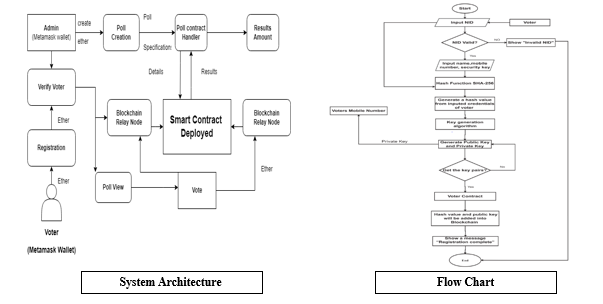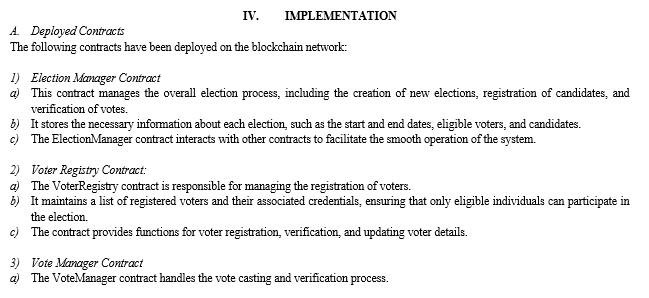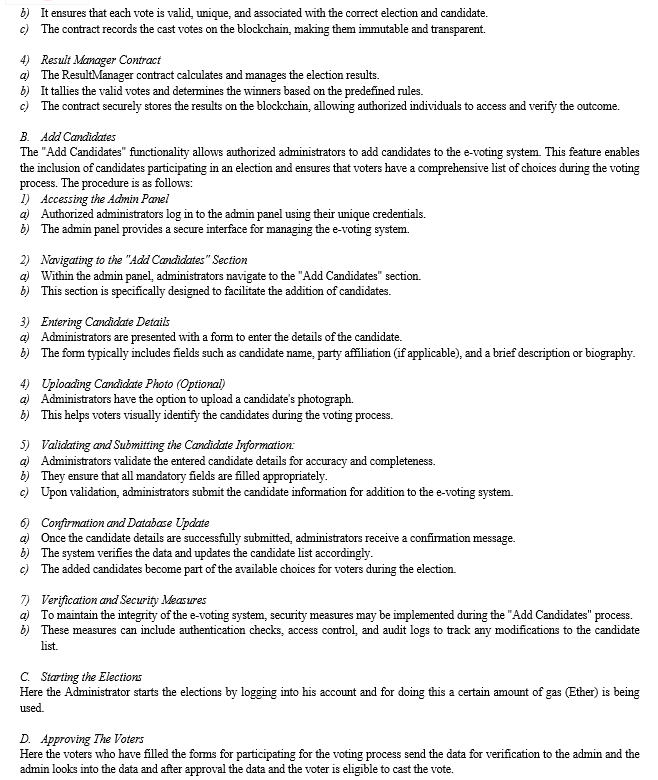Ijraset Journal For Research in Applied Science and Engineering Technology
- Home / Ijraset
- On This Page
- Abstract
- Introduction
- Conclusion
- References
- Copyright
Secured E-voting System Using Blockchain Technology
Authors: Prof. Afsha Akkalot, Parth Vijaykumar Lashkare, Hemant Patel, Dharmendrasingh Rajpurohit
DOI Link: https://doi.org/10.22214/ijraset.2023.52849
Certificate: View Certificate
Abstract
The emergence of blockchain technology has paved the way for the development of secured e-voting systems that are transparent, immutable, and tamper-proof. In this survey report, we examine the current trends and future prospects of using blockchain technology for e-voting. We begin by exploring the key features of blockchain technology, including distributed ledger, cryptographic security, and decentralized consensus mechanisms. Next, we discuss the benefits of using blockchain technology for e-voting, including voter anonymity, transparent voting process, and immutable voting records. To gain a better understanding of the current state of the field, we conducted a survey of recent literature on blockchain-based e-voting systems. The survey covers research articles, white papers, and conference proceedings published in the last five years. We analysed the data using statistical software and present our findings on the most commonly used consensus algorithms, cryptographic techniques, and blockchain architectures in e-voting systems. Our survey also highlights the challenges facing the adoption of blockchain-based e-voting systems, including scalability, usability, and regulatory issues. We conclude by discussing the future prospects of blockchain-based e-voting systems and identifying the areas that require further research and development. Overall, this survey report provides valuable insights into the current trends and future prospects of using blockchain technology for e-voting, and will be useful for researchers, policymakers, and practitioners working in this field.
Introduction
I. INTRODUCTION
Electronic voting (e-voting) systems have the potential to revolutionize the way we conduct elections by making the process more efficient, transparent, and accessible to a wider range of voters. However, the use of traditional e-voting systems has been marred by concerns over security, privacy, and transparency. In recent years, blockchain technology has emerged as a promising solution to these issues by providing a secure, decentralized, and transparent platform for e-voting.
Several studies have examined the potential of blockchain technology for e-voting systems. For instance, in their paper "A Blockchain Based Voting System",[1] Böhme et al. (2015) proposed a blockchain-based e-voting system that provides end-to-end encryption and a decentralized verification mechanism to ensure the integrity of the voting process. Similarly, in their paper "E-Voting using Blockchain Technology",[2] Kshetri and Voas (2018) argue that blockchain technology can enhance the security, privacy, and transparency of e-voting systems by using cryptographic techniques to ensure the anonymity and integrity of the voting process.
While these studies provide valuable insights into the potential of blockchain technology for e-voting systems, there is still a need for a comprehensive survey of the current trends and future prospects of using blockchain technology for e-voting. In this survey report, we aim to fill this gap by providing a comprehensive overview of the key features, benefits, challenges, and future prospects of using blockchain technology for e-voting systems.
II. METHODOLOGY
A. Requirement Gathering
Requirement gathering is an essential process that helps in identifying the needs and expectations of stakeholders from the system. In order to gather the requirements for our e-voting system using blockchain, we followed the following steps:
- Analysed Existing Systems: We analysed the existing voting systems in India, including manual and electronic voting systems, to understand their limitations and drawbacks. We also analysed the existing blockchain-based e-voting systems used in other countries to identify the best practices.
- Defined the scope: Based on the inputs gathered from the stakeholder meetings and the analysis of existing systems, we defined the scope of our e-voting system using blockchain. We identified the key features, functionalities, and components required in the system.
- Created use cases: We created use cases to describe the system behaviour from the perspective of different stakeholders. This helped us to identify the various scenarios in which the system would be used and the requirements for each scenario.
- Developed Requirement Specification: Based on the scope and use cases, we developed a detailed requirement specification document that outlined the functional and non-functional requirements of the system. The document included features like voter registration, authentication, voting process, blockchain-based vote storage, and result declaration.
B. System Design
The system design is an important aspect of the methodology that outlines the technical specifications of the proposed e-voting system. The system design is divided into two parts, i.e., architecture design and database design.
- Architecture Design: The architecture design defines the system's high-level structure, modules, and their relationships.
- Client-Side Application: This component provides an interface to the users to cast their votes securely. Server-Side Application: This component receives the votes from the client-side application and forwards them to the blockchain network.
- Blockchain Network: This component stores the votes securely in blocks and maintains a distributed ledger of the votes
- Admin Panel: This component allows authorized users to monitor and manage the system's operations.
C. Development
The development phase of our research project involved the implementation of the secured e-voting system using blockchain technology. This section outlines the step-by-step process we followed to transform our design into a functional and robust system.
- Smart Contract Development: We utilized the Solidity programming language to develop smart contracts that govern the core functionality of the e-voting system. The smart contracts were deployed on the Ethereum blockchain, leveraging its decentralized nature and immutability.
- User Interface Design: To provide a user-friendly experience, we designed an intuitive web-based interface for voters to interact with the e-voting system. The interface allowed voters to securely access their voting profiles, cast their votes, and verify the transparency of the process.
- Integration of Blockchain Technology: We integrated the developed smart contracts with the web application, establishing a seamless connection between the user interface and the underlying blockchain infrastructure. This integration ensured that the voting process remained secure and transparent.
- Security Measures: To enhance the system's security, we implemented various measures. These included cryptographic techniques for user authentication and encryption of sensitive data, ensuring that only authorized individuals could access and modify the system.
- Testing and Quality Assurance: Extensive testing was conducted to validate the functionality and reliability of the e-voting system. We performed unit tests to verify the correctness of individual smart contracts and integration tests to assess the system's behavior as a whole. Additionally, we simulated real-world voting scenarios to evaluate the system's performance under different conditions.
- Performance Optimization: During the development phase, we focused on optimizing the system's performance to ensure scalability and responsiveness. We employed efficient algorithms for vote counting and result generation, minimizing the computational overhead and enhancing the overall efficiency of the system.
- Iterative Development: Our development process followed an iterative approach, allowing us to incorporate feedback and make necessary improvements. We actively engaged with stakeholders, including election officials and potential voters, to gather their insights and refine the system based on their suggestions and requirements.
D. Testing and Evaluation
The testing phase of our research project aimed to verify the functionality, reliability, and security of the developed secured e-voting system. Rigorous testing methodologies were employed to ensure that the system meets the defined requirements and operates as expected. This section provides an overview of the testing strategies and techniques utilized during this phase.
- Unit Testing: We conducted comprehensive unit testing to validate the individual components and smart contracts of the e-voting system. Each unit was tested in isolation to ensure its correctness and adherence to the system's specifications. This involved writing test cases that covered various scenarios and edge cases to uncover any potential bugs or logical flaws.
- Integration Testing: Integration testing was performed to assess the interactions between different components of the e-voting system. This included verifying the seamless communication between the user interface and the smart contracts deployed on the blockchain. Integration tests were designed to evaluate the correctness of data flow, transaction handling, and system responses.
- System Testing: System-level testing was conducted to evaluate the overall functionality and performance of the e-voting system. We simulated real-world voting scenarios and assessed the system's behavior under different loads and stress conditions. This involved conducting end-to-end tests to verify the complete voting process, including user registration, vote casting, and result generation.
- Security Testing: Given the critical nature of the e-voting system, extensive security testing was carried out to identify and mitigate any vulnerabilities or potential exploits. We conducted penetration testing, vulnerability assessments, and code reviews to ensure the system's resilience against security threats such as tampering, data manipulation, and unauthorized access. Measures were taken to protect user data and maintain the confidentiality and integrity of the system.
- Usability Testing: Usability testing was performed to assess the user-friendliness and accessibility of the e-voting system. We collected feedback from a diverse group of users, including potential voters and election officials, to evaluate their experience and identify areas for improvement. Usability tests focused on aspects such as intuitive navigation, clear instructions, and user satisfaction.
- Performance Testing: Performance testing was conducted to evaluate the responsiveness and scalability of the e-voting system. We measured response times, throughput, and resource utilization under varying load conditions to ensure that the system can handle a large number of concurrent users without compromising its performance. Performance tests were carried out using both simulated and real-world scenarios.
- Acceptance Testing: Acceptance testing involved involving stakeholders, such as election officials and potential voters, to validate the e-voting system against their requirements and expectations. The system was presented to them for evaluation, and their feedback was collected to assess its compliance with their needs and preferences. This feedback was valuable in fine-tuning the system and ensuring its acceptance.
III. SYSTEM ARCHITECTURE AND FLOWCHART
A. System Architecture
The system architecture of the secured e-voting system using blockchain technology is designed to ensure a robust and transparent voting process. The architecture comprises several interconnected components that work together to facilitate secure and verifiable electronic voting.
At the core of the system lies the blockchain network, which serves as the immutable ledger for recording and storing the votes. The blockchain is decentralized and distributed across multiple nodes, ensuring data integrity and resistance to tampering. Smart contracts, implemented using Solidity programming language, govern the execution of voting operations and enforce the predefined rules and regulations.
The system architecture incorporates a separate database for administrative purposes, keeping the sensitive data segregated from the public-facing web application. The database stores flagged data and enables the authorized administrators to review and handle any identified issues. This ensures the accuracy and integrity of the voting results.
B. Flow Chart
- User Registration
a. Users access the web application and initiate the registration process.
b. They provide the necessary identification details and are verified against the eligibility criteria.
c. Upon successful verification, their credentials are stored securely in the system.
2. Vote Casting
a. Registered users log in to the system using their credentials.
b. They are presented with the list of candidates or options for the ongoing election.
c. Users make their selection and confirm their vote.
d. The vote transaction is securely recorded on the blockchain network.
3. Verification and Tallying
a. After the voting period ends, the system verifies the authenticity and validity of each vote.
b. Smart contracts execute the verification process, checking for duplicate votes or any tampering attempts.
c. Verified votes are tallied, and the results are calculated.
4. Result Generation
a. The calculated results are securely stored on the blockchain network.
b. Authorized individuals can access the system and retrieve the election results.
c. The results are displayed on the user interface, providing transparency and accountability.




V. FUTURE WORK
- Integration with AI and Machine Learning: One possible future direction for a blockchain-based e-voting system is to integrate it with AI and machine learning techniques. This can enable the system to learn from previous voting patterns and predict future outcomes more accurately.
- Enhanced Security Measures: Another potential area for future work is the development of more advanced security measures to protect the voting data from cyber-attacks. This can include the use of advanced encryption algorithms, biometric authentication techniques, and multi-factor authentication protocols.
- Improved Accessibility and User Experience: A key challenge with e-voting systems is ensuring that they are accessible and easy to use for all voters. Future work can focus on developing more user-friendly interfaces and providing additional support for voters with disabilities.
- Integration with Social Media Platforms: Social media platforms have emerged as powerful tools for political campaigning and voter mobilization. Integrating a blockchain-based e-voting system with social media platforms can enable campaigns to reach a wider audience and encourage greater voter participation.
- International Standardization: Finally, future work can focus on developing international standards for e-voting systems that can be adopted by governments and election commissions around the world. This can help to ensure the security, transparency, and accuracy of e-voting systems and enhance public trust in the democratic process.
Conclusion
As the project progresses, we can conclude that the development of a secured e-voting system using blockchain technology is a promising solution to the challenges faced by traditional voting systems. By leveraging the features of blockchain, such as security, transparency, and decentralization, we can ensure the integrity and trustworthiness of the democratic process. We have made significant progress in the development of our e-voting system, including designing and implementing a blockchain-based architecture and creating a Solidity program that ensures the security of the voting data. However, there are still challenges to overcome, such as ensuring accessibility and usability for all voters, and addressing regulatory and legal barriers. As we continue to progress with the project, we must remain vigilant in addressing these challenges and incorporating feedback from stakeholders and experts. Collaboration and coordination with policymakers, election commissions, and other stakeholders will be critical to ensure that the final product meets the needs and requirements of all parties involved. Overall, we are confident that our project will contribute to the advancement of the field of e-voting systems and blockchain technology, and we look forward to seeing the impact of our work on the democratic process.
References
[1] Böhme, R., Christin, N., Edelman, B., & Moore, T. (2015). A blockchain-based voting system. In Financial Cryptography and Data Security (pp. 556-570). Springer, Berlin, Heidelberg.IEEE, “Missing Data Analysis in Regression,” 2022. [2] Kshetri, N., & Voas, J. (2018). E-Voting using blockchain technology. In Blockchain and Applications (pp. 219-236). Springer, Cham. [3] Agrawal, R., Kumar, S., & Sharma, M. (2018). A Blockchain Based E-Voting System for Elections. International Journal of Advanced Research in Computer Science, 9(2), 45-49. [4] Kalra, A., & Sharma, M. (2019). Hybrid e-voting system using blockchain and homomorphic encryption. Proceedings of the 10th International Conference on Computing, Communication and Networking Technologies (ICCCNT),
Copyright
Copyright © 2023 Prof. Afsha Akkalot, Parth Vijaykumar Lashkare, Hemant Patel, Dharmendrasingh Rajpurohit. This is an open access article distributed under the Creative Commons Attribution License, which permits unrestricted use, distribution, and reproduction in any medium, provided the original work is properly cited.

Download Paper
Paper Id : IJRASET52849
Publish Date : 2023-05-23
ISSN : 2321-9653
Publisher Name : IJRASET
DOI Link : Click Here
 Submit Paper Online
Submit Paper Online

